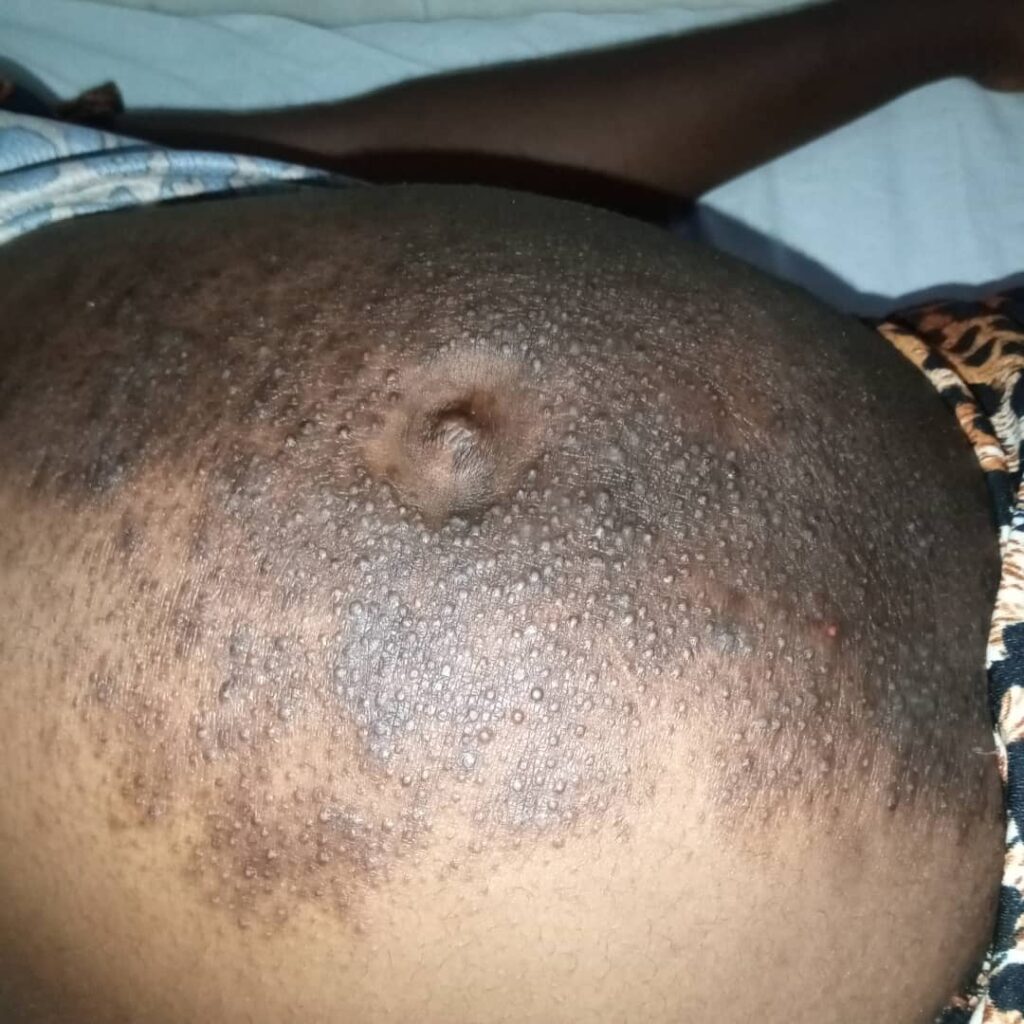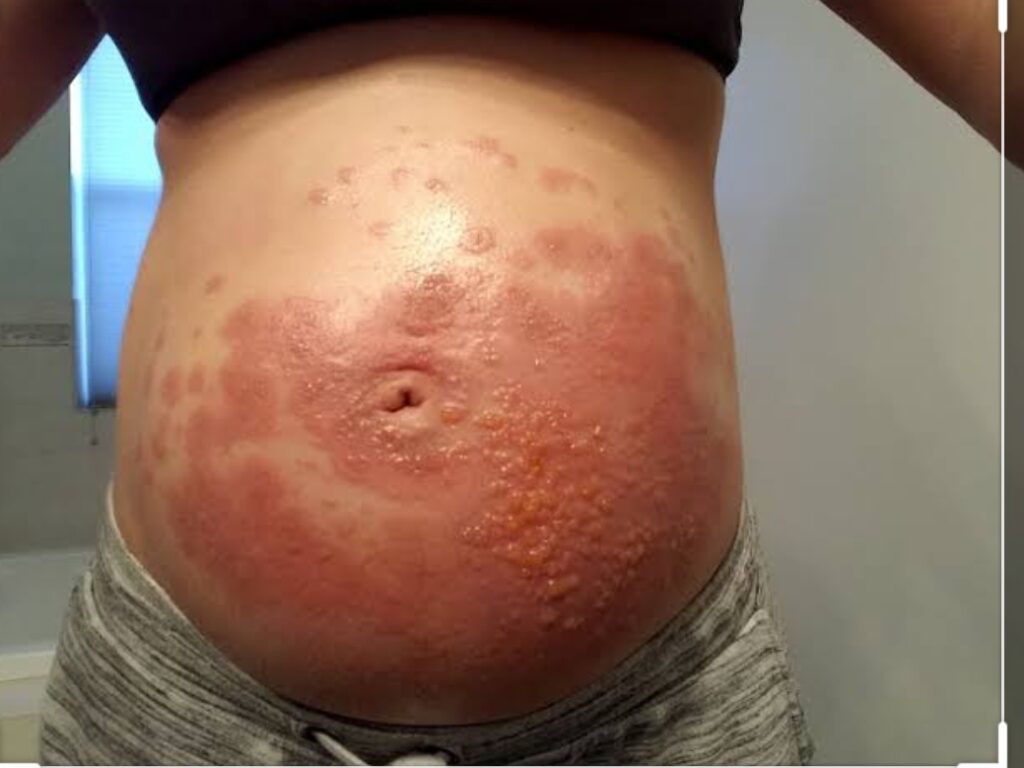Pregnancy is that nine month period that is characterised by physiological changes (natural changes that occur in everyone that is pregnant to accommodate all the body changes that occur in pregnancy). There are some skin conditions called pregnancy induced dermatoses that are associated with pregnancy and are NOT particularly due to the physiological changes in pregnancy. These conditions have an ill-defined cause and are usually associated with itching. The risk factor for having these skin conditions is the pregnancy itself and some tend to occur in first time pregnancies rather than subsequent pregnancies. Some usually recur even in subsequent pregnancies. Most of these skin conditions will start in second or third trimester (which is about 4th month and 7th month of pregnancy respectively.
The physiological changes in pregnancy usually due to hormones include stretch marks, weight gain, darkening of certain areas of the skin (called melasma) amongst others. The focus of this post is not on the physiological changes which every pregnant woman will experience one way or the other during pregnancy. There are also some background skin conditions that the woman had prior to pregnancy which may improve or worsen with pregnancy e.g Psoriasis. There are other conditions that occur more frequently because of the depressed immunity of pregnancy e.g candidiasis.
The focus of this post is however on the pregnancy induced dermatoses which is not seen at any other period EXCEPT in pregnancy. Most are self limiting and will resolve latest by a few weeks post delivery but a few of them may have some effects on the fetus and may need active fetal surveillance.
The pregnancy induced dermatoses include Atopic eruption of pregnancy (which has 3 types -eczema of pregnancy, pruritic eruption of pregnancy and pruritic folliculitis), pemphigoid gestationis, Polymorphic eruption of pregnancy (PEP) also called pruritic urticarial papules and plaques of pregnancy [PUPPP], and intrahepatic cholestasis of pregnancy (ICP). The word ‘pruritus’ in medicine refers to itch. So most of these conditions are itchy.
1. By far the most common of these conditions is atopic eruption of pregnancy that makes up about 50%. This is also the one that starts a bit earlier compared to other ones as it may start as early as first trimester (first 3 months). It may occur in patients with background atopic dermatitis (sensitive skin) or may occur newly for the first time. Usually made of itchy lesions on the skin which may include patches, papules and may be generalized in the case of eczema of pregnancy or maybe limited to arms and legs and occasionally abdomen in the case of prurigo of pregnancy. These first two tend to start in the first trimester. The last type of atopic eruption of pregnancy called prurigo folliculitis start like eruptions from the follicles on the skin usually on the chest, back and abdomen unlike the first two and are not particularly itchy. It also tends to start later in the first trimester or second trimester unlike the other two sub classes of atopic eruption of pregnancy. Other causes of folliculitis like fungal folliculitis must be excluded. Atopic eruption of pregnancy does not usually cause fetal issues.
Atopic eruption of pregnancy may recur in subsequent pregnancies.

2. Polymorphic eruption of pregnancy also known as pruritic urticarial papules and plaques of pregnancy (PUPPP) is the second most common skin dermatosis in pregnancy after atopic eczema. It is associated with multiple gestation and increased maternal weight gain. The exact cause is not known. It has been proposed that stretching of the skin damages the connective tissue. PUPPP usually occurs in primigravidas (first timers) in the third trimester and recurrence in subsequent pregnancies is UNUSUAL. The eruption may first appear in postpartum period (after delivery) PUPPP has a marked itching component and the onset of itching coincides with the skin lesions which are seen as polymorphous (different shapes), erythematous (reddish) , nonfollicular papules, plaques, and sometimes vesicles. The eruption begins over the abdomen, commonly involving striae gravidarum (stretch marks on the tummy) with sparing of the periumbilical region (around the umbilicus). It may spread to the breasts, upper thighs, and arms. The face, palms, soles, and mucosal surfaces are usually spared. The lesions resolve near term or in the early postpartum period. The maternal and fetal outcome is excellent.

3. Pemphigoid gestationis is a rare autoimmune disorder and usually starts in the second or third trimester. The condition has been linked to the presence of some certain HLAs like DR3 &4 and has a rare association with molar pregnancies and choriocarcinoma. The skin lesions are itchy, urticarial (wheals) and vesiculobullous and the lesions may start around the umbilical region unlike 2 above. The condition may resolve late in pregnancy, but classically flares up again at delivery. Fetal risk has not been substantiated, although immunoglobulin G autoantibodies cross the placenta, and 5 to 10 percent of newborns have urticarial, vesicular or bullous lesions. Mild placental failure has been associated with premature deliveries and newborns that are small for gestational age. Therefore, antenatal surveillance is advised. Affected patients may have nongestational recurrences triggered by oral contraceptives and menstrual cycles. Therefore…it is one of those that may recur in subsequent pregnancies.

4. The two terms term pruritus gravidarum and intrahepatic cholestasis of pregnancy (ICP) have been used interchangeably. While the former is classically associated with itching, without ANY skin lesions and occurs in the first trimester, ICP (also called obstetric cholestasis) is seen in last trimester and is characterized by pruritus with or without jaundice, absence of primary skin lesions, and with laboratory markers of cholestasis (obstruction of bile flow). The skin lesions are usually linear excoriations and excoriated papules, which are caused by scratching and are localized on the extensor surfaces of the limbs, abdomen and back. The severity of skin lesions correlates with the duration of pruritus (i.e the longer the itching, the more the severity of skin lesions). The cause of ICP remains controversial. A family history of the condition is common, and there is an association with the presence of some HLA – A31 and B8. The condition tends to recur in subsequent pregnancies. Patients may have a family history of cholelithiasis and a carry higher risk of gallstones. Laboratory markers include elevated serum bile acid levels and alkaline phosphatase levels and bilirubin levels may also be high. It is associated with a higher risk of premature delivery, meconium-stained amniotic fluid, and intrauterine death due to anoxia (no oxygen available) caused by decreased fetal elimination of toxic bile acids. An increase in adverse fetal outcomes has been reported in patients with bile acid levels of 16.34 mcg per mL.
Cholestasis and jaundice in patients with severe or prolonged intrahepatic cholestasis of pregnancy may cause vitamin K deficiency and coagulopathy (abnormal bleeding and clotting). Therefore, early diagnosis, prompt treatment, and close obstetric surveillance are mandatory in cases of ICP.
To summarize because I know you’re having a headache already..lol. These skin conditions are specific to pregnancy and are usually associated with itching except for prurigo folliculitis where itching may be mild. They may recur in subsequent pregnancies like 1, 3 and 4. May be associated with adverse fetal outcomes especially 4 and 3. Will resolve after pregnancy. 2 may start for the first time shortly after delivery.
Management is by counseling and reassuring the patient, treat symptomatically e.g the itching with antihistamines, liberal moisturizing, benzoyl peroxide cream may be needed for pruritic follicullitis (that type of atopic eruption that is not especially itchy), some steroids may be needed especially with marked inflammation and itching, ursodeoxycholic acid is usually the best treatment for intrahepatic cholestasis of pregnancy. Fetal and maternal surveillance may be necessary especially in 4 and 3. It is important to let the patient know which ones may occur in subsequent pregnancies.
I hope I’ve been able to demystify pregnancy induced dermatoses to you. You can read more in this article that served as my reference for this write up (especially if you’re a doctor).
https://www.ncbi.nlm.nih.gov/pmc/articles/PMC2763729/#:~:text=Pregnancy-specific%20skin%20dermatoses%20include,and%20intrahepatic%20cholestasis%20of%20pregnancy.
Thank you to Dr. Bello Awwal who suggested I talk about this because of a patient that he saw that graciously allowed us to use her pictures. Dr. Awwal’s patient has atopic eruption of pregnancy (likely pruritic folliculitis).
Any questions, comments or clarifications?

Good day ma,
I just went through this article on your website and I found it very resourceful. Please ma, am athematic and suffer from eczema on my back and face.
Kindly recommend or prescribe medications for me.
Thanks.
Thank you for reading. But I have mentioned several times that I don’t consult here. There’s a link to book a consultation on my website if you’d like.
My partner and I absolutely love your blog and find almost all of your post’s to be
what precisely I’m looking for. Do you offer guest writers to write content for
you? I wouldn’t mind producing a post or elaborating on some of the subjects
you write concerning here. Again, awesome web log!
Howdy! I simply would like to give a huge thumbs up for the great data you have right here on this post. I shall be coming back to your blog for extra soon.
Great V I should certainly pronounce, impressed with your site. I had no trouble navigating through all the tabs as well as related info ended up being truly easy to do to access. I recently found what I hoped for before you know it at all. Reasonably unusual. Is likely to appreciate it for those who add forums or anything, website theme . a tones way for your customer to communicate. Nice task..